Adolphe Gouhenant was born in France in 1804, just five years after the French Revolution. And he made his mark in Fort Worth early: He was dead two years before Fort Worth incorporated, dead five years before the first railroad came to town.
Today in Fort Worth he is remembered by his anglicized name, “Adolph Gounah.” He also is remembered as Fort Worth’s first Renaissance man. He was an artist, daguerreotypist (photographer), language and music teacher, physician, fencer, winemaker.
And he was a gypsy. Gounah immigrated to Texas in June 1848 in the second wave of members of the short-lived French utopian colony New Icarie in Denton County. The colony was founded on Peters Colony land six years before La Reunion utopian colony was founded in Dallas County by French, Belgian, German, and Swiss immigrants.
When the New Icarie colony failed in 1849, Gounah moved thirty miles south to the Army’s new Fort Worth, where he had a Peters Colony land grant northeast of the fort in today’s Samuels Avenue area. According to Julia Kathryn Garrett in Fort Worth: A Frontier Triumph Gounah also befriended fort commander Major Ripley Arnold and gave Arnold’s children lessons in French, riding, and music. Gounah also gave the fort’s soldiers lessons in fencing.
He also may have been the Frenchman of Frenchman’s Well.

This 1850 census lists the Arnold household at the fort. That year two of the Arnold children, Sophia and Willis, died. Gounah had them buried on land belonging to Middleton Tate Johnson. Three years later Major Arnold was killed at Fort Graham (near Hillsboro) in a duel with fort surgeon Josephus Steiner. Two years later friend Gounah again rose to the occasion. He and Johnson and other Masons had Arnold’s body disinterred and returned to Fort Worth for burial next to Arnold’s children. Gounah later bought the land from Johnson’s estate. That land, together with an adjoining parcel donated by Baldwin Samuel, became Pioneers Rest Cemetery.

Streets bordering the cemetery are named for Gounah and Samuel.
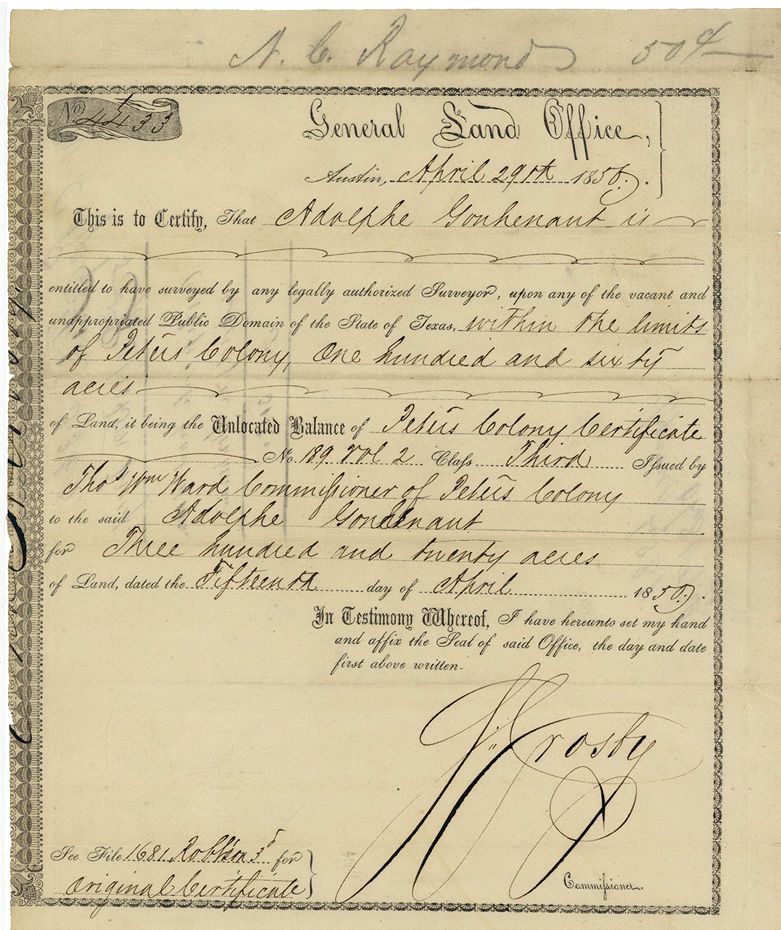 An 1850 General Land Office certificate for Gounah’s Peters Colony land grant in Fort Worth.
An 1850 General Land Office certificate for Gounah’s Peters Colony land grant in Fort Worth.
Gounah also lived in Dallas. By 1852 he had opened one of the first art studios in Dallas on the courthouse square. In his “art saloon” he painted, made daguerreotypes, taught French and Spanish and a half-dozen musical instruments. The saloon also served as a Masonic lodge hall, dance hall, and Sunday school. Even district court sessions were held there. Gounah was paid $7.50 per court session for the use of his space.
On July 7, 1852 Charles DeMorse of the Northern Standard newspaper of Clarksville (northeast Texas) wrote of his visit to the art saloon: “. . . we proceeded to the Saloon and found a dance in full operation, in which besides the ladies and resident gentlemen, were participating Maj. Arnold, the gentlemanly commandant of Ft. Worth, and Maj. Young, the Sutler for the post. We found the main room of the Saloon large enough for two sets at a time, and in a little recess at one side was an honorable member of the legislature playing the violin assisted by Mons. Gouhenant. The Saloon itself was draped with flesh-colored canvass [sic], and pleasantly lighted, and to the best of my ability, I represented the City of Clarksville upon the dance floor.”

From Dallas Gounah moved on. By 1856 Gounah and wife Elizabeth were living in Pilot Point, Denton County, where they raised cattle and horses. In 1859 Gounah was convicted of dispensing quack medicine. In 1866 he was listed on a federal tax assessment roll as an “apothecary.”
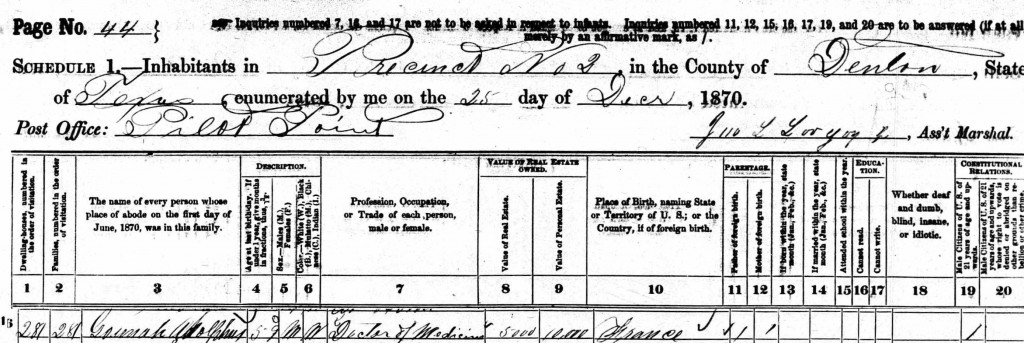
By 1870 Gounah was listed on the census as a “doctor of medicine” in Pilot Point.
And it was about that time that Gounah had a dream one night. The dream so affected him that he recorded it in his diary, later found by his family. In the dream Gounah was traveling to Washington, D.C. when he fell while boarding a railroad car in some town in Missouri and was severely injured. Gounah dreamed that he was cared for by brothers of the Mystic Tie (a branch of Masonry to which he actually belonged) and by the Sisters of Charity. Gounah dreamed that he died and that the next day his wife Elizabeth wept over his body.
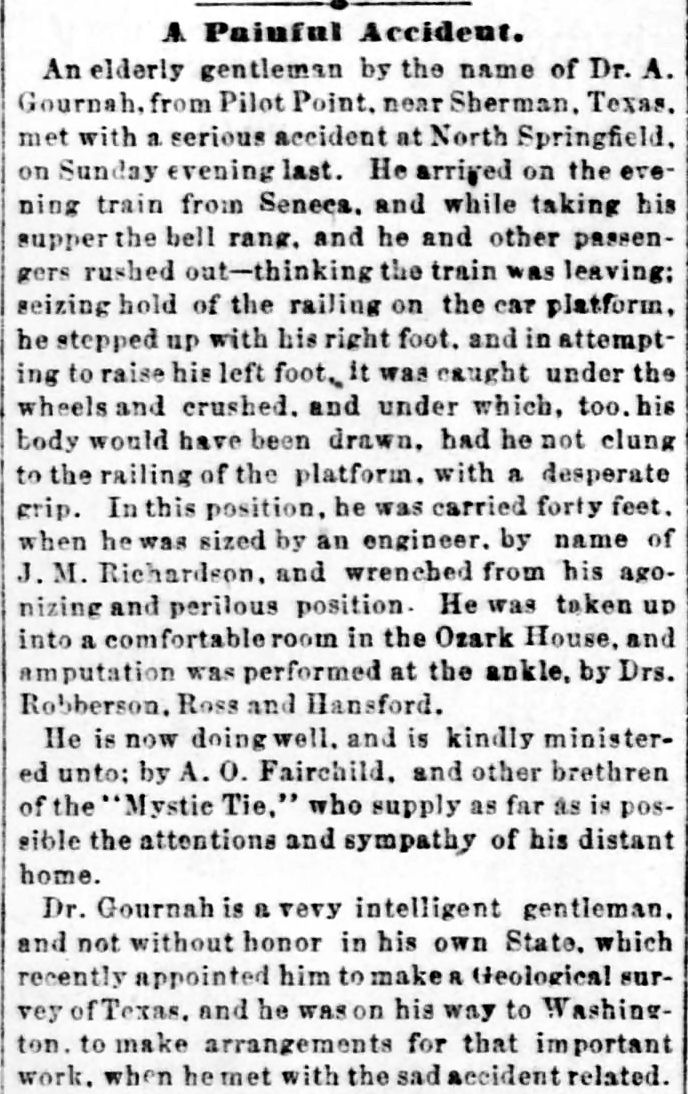
This clip from the Springfield, Missouri Weekly Patriot of April 27, 1871 bears out part of Gounah’s dream.
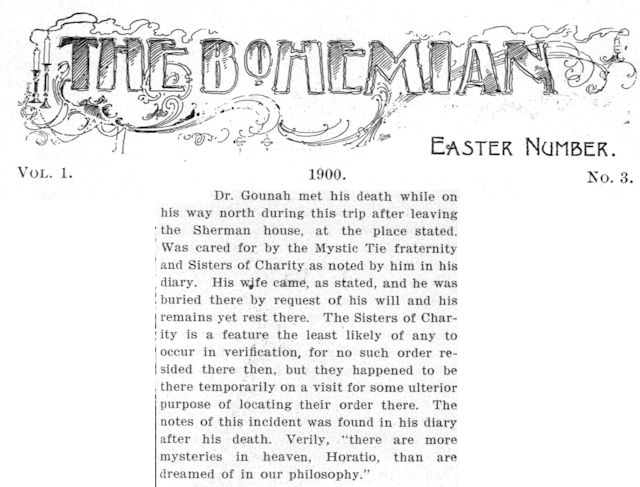
Local historian Judge C. C. Cummings and Alex W. Robertson wrote about Gounah’s dream in 1900 in The Bohemian, a literary magazine published in Fort Worth from 1899 to 1907.

This clip is from the Dallas Weekly Herald. Gounah died on April 30, 1871 and indeed was buried where he had dreamed he would die. Sometime after 1885 his family provided his grave in Springfield’s Hazelwood Cemetery with a headstone of pink granite left over from construction of the capitol building in Austin.
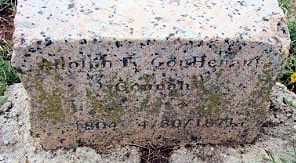 (Photo from Find a Grave.)
(Photo from Find a Grave.)






Thanks for the posting about Gouhenant, providing a link to my book, and for providing a forum-I hope to connect with a long lost cousin based on his comment on your site. Cheers!
Indeed!! Thank you again for this article and Paula for your amazing book.
I sent this article to my niece who will be traveling to France to show her our bloodline.
Good Morning Paula,
Not sure how to start, but I was going thru some of Granddads (Cecil Gounah Ewing) old letters from Carolyn Selzer. I never new the history of the Gounah family and I found it very interesting. My name is Susan Maggio Ewing, (husband is Surrey Ewing - Cecil Surrell Ewing). I purchased your book at Barnes and Nobles and to arrive in Jan. Can’t wait to read. I found this history fascinating and kept reading more. I too love genealogy and tracing back your roots. I immediately told my oldest son where he inherited his talent from - a self taught Photographer and videographer. His company is Wacky Rig Productions. Landon Surrell Ewing. Our youngest son is Lance Alexander Ewing. Granddad spoke with Hattie and Carolyn (I believe they were twins). I would love to hear back from you. Hope you have a wonderful 2023 New Year.
Hometown,
Thank you for this article. I would love to learn more about Adolphe Gouhenant. I need to find or create a family tree to see how I’m connected to him.
Best Regards,
(Trey) Aubrey Lafont Gounah III
Thanks, Aubrey. He was a fascinating figure. Unfortunately he died so long ago that I have not found much written about him.
Hello to both Hometown, and Aubrey Gounah III. Aubrey, are you Boyd’s grandson? I am Julia Gounah’s great grand daughter. Please check out my book Adolphe Gouhenant: French Revolutionary, Utopian Leader, and Texas Frontier Photographer, published by UNT press, 2019. My co-author and I researched Gouhenant for more than 6 years to write Gouhenant’s biography. His life in France and Texas was fascinating.
Here’s a link to Adolphe Gouhenant: French Revolutionary, Utopian Leader, and Texas Frontier Photographer about a most interesting early Fort Worth resident.
Just a follow up on this Important event and person that Hometown By Handlebar had posted some years back and thanking them again for doing so,….
All the while we are here today and everyday and having to say that History….. Is Important everyday today, it is about how we say it and what we say, may it be 50 percent fact or 50 percent folklore, meanwhile a lie is also knowing an important fact and leaving it out, it also may be the fact that finishes out why that event had such tragic or joyous endings…
The Dallas Photographer here was left out of the History of La Reunion since he was,well difficult to understand…Mad or just a visionary and so again more should be said about Ft. Worth and La Reunion in the future..
It may tell alot about what we may realize also about today…
Thank you, Alexander. It’s indeed frustrating when such an important figure in our history is so cloaked in mystery.
Thank you for posting these details. [We] place[d] a tombstone on his grave in 1996 in Springfield, Mo. I want to also thank George and Pat Crowley for their great efforts and the late Jack Grantham and the late Jim Wheat for their efforts and help in the creation of this man’s life and efforts in the North Texas region and much thanks to Paula and Carolyn and Simon Selzer for their efforts as family members.
And thank you, Mr. Troup, for preserving the memory of one of the most interesting people in early North Texas history.